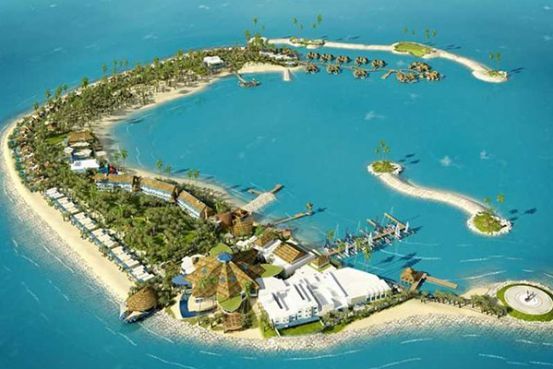Sierra Leone Geographical Location
 Sierra Leone is bordered on the north and east by Guinea, on the south by Liberia, and on the west by the Atlantic Ocean.
Sierra Leone is bordered on the north and east by Guinea, on the south by Liberia, and on the west by the Atlantic Ocean.
The country can be divided into four distinct physical regions: the coastal swamp, the Sierra Leone Peninsula, the interior plains, and the interior plateau and mountain region. The coastal swamp region extends along the Atlantic for about 200 miles (320 km). It is a flat, low-lying, and frequently flooded plain that is between 5 and 25 miles (8 and 40 km) wide and is composed mainly of sands and clays. Its numerous creeks and estuaries contain mangrove swamps. Sandbars, generally separated by silting lagoons, sometimes form the actual coast. The Sierra Leone Peninsula, which is the site of Freetown, is a region of thickly wooded mountains that run parallel to the sea for about 25 miles (40 km). The Peninsula Mountains rise from the coastal swamps and reach some 2,900 feet (880 metres) at Picket Hill.
Inland from the coastal plain is the interior plains region. In the north, it comprises featureless seasonal swamps known as “Bolilands” (boli being a Temne word for those lands that are flooded in the rainy season and dry and hard in the dry season and on which only grass can grow). In the south, the plains comprise a rolling wooded country where isolated hills rise abruptly to more than 1,000 feet (300 metres).
The interior contains a variety of landforms ranging from savanna-covered low plains to rocky scarp and hill country. The interior plateau and mountain region, encompassing roughly the eastern half of the country, is composed mainly of granite with a thick laterite (iron-bearing) crust; to the west, it is bounded by a narrow outcrop of mineral-bearing metamorphic rocks known as the Kambui Schists. Rising above the plateau are a number of mountain masses; in the northeast, the Loma Mountains are crowned by Mount Loma Mansa (Mount Bintimani) at 6,391 feet (1,948 metres), and the Tingi Mountains rise to 6,080 feet (1,853 metres) at Sankanbiriwa Peak. Numerous narrow inland valley swamps associated with the river systems occur in this region.
History of Sierra Leone
Prior to the arrival of Pedro da Cintra in 1462, Sierra Leone’s history can be briefly ascribed to its composition of few ethnic groups, prominent amongst these were Limba who already lived in Sierra Leone around the 8th Century and there is no clear evidence about their origin. The other ethnic groups included Themnes, Sherbros, Yalunkas and Soso were believed to have originated from the Upper Guinea Coast, whilst the Mendes were believed to have originated from the Mande Ethnic Group from the Mali Empire led by Queen Massarico. The Creoles, a descendant from the Nova Scotia, Maroons and Recaptives.
Additionally, a significant part of Sierra Leone’s history can be ascribed to the arrival of Pedro da Cintra, a Portuguese Explorer. He arrived along the West African coast during the rainy season in September 1462. In seeing the shape of mountains like a Lion and amidst the thunderstorm he named the mountains ‘Sierra Lyoa’ (meaning Lion Mountains in Portuguese) Later, the name Sierra Leone was derived from the Portuguese term Sierra Lyoa.
After Pedro da Cintra’s discovery, foreign influence in the area increased and trade commenced between the locals and Europeans in the form of a barter system. The British began to take interest in Sierra Leone and in 1672 the Royal African Company established trading forts on the Islands of Bunce and York. With the emergence of the slave trade, human trafficking became the major commodity and indigenes were sold as slaves. Bunce Island became a prime spot for transporting slaves to Europe and America. When the Trans-Atlantic Slave Trade was abolished in 1806, the freed slaves from Britain and the Americas were repatriated to the capital which was named Freetown.
In 1808, Sierra Leone became a British crown colony, ruled under a colonial governor. The British administration favoured a policy of “indirect rule” whereby they relied on slightly reorganized indigenous institutions to implement colonial policies and maintain order. Rulers who had been “kings” and “queens” became instead “paramount chiefs,” some of them appointed by the administration, and then forced into a subordinate relationship. This allowed the crown to organize labour forces for timber cutting or mining, to grow cash crops for export, or to send work expeditions to plantations as far away as the Congo. Sierra Leoneans did not passively accept such manipulations. The 1898 “Hut Tax rebellion” occurred as a response to British attempts to impose an annual tax on all houses in the country. The Temne and Mende people especially refused to pay, attacking and looting trading stations, and killing policemen, missionaries, and all those suspected of assisting the colonial government.
Pressures to end colonialism had as much to do with Britain’s weakened position following World War II as it did with the pan-African demands for autonomy. Sierra Leone became an independent, sovereign state on 27 April 1961 with Milton Margai as its Prime Minister. Ten years later, on 19 April 1971, the country became a republic, with an elected President as the Head of State.
